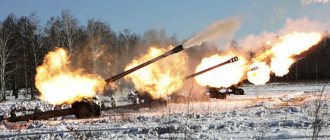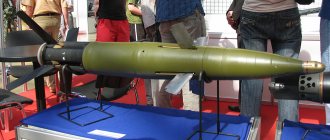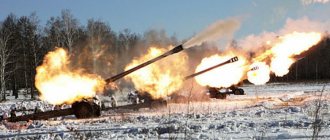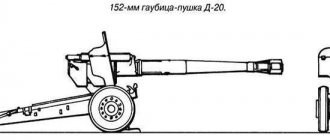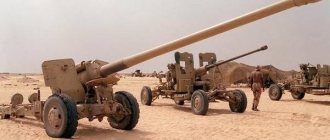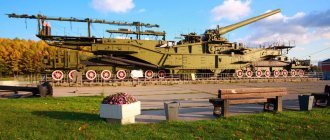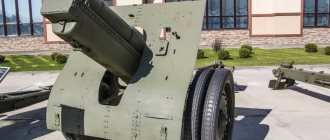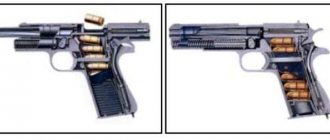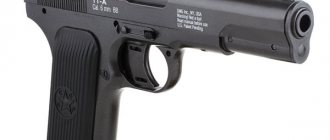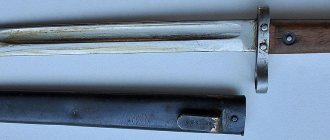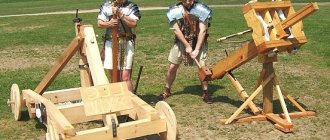The young Soviet state received from the tsarist army weapons of outdated models, which often had no prospects for development. This was especially true for medium and large caliber artillery. Therefore, already at the end of autumn 1920, a new design bureau was created, headed by F.F. Lander. Organizationally, the bureau was part of the Artillery Committee, and therefore received the short designation KB Artkom.
One of the bureau's developments was the B-4 heavy howitzer, which was widely used in the Winter War and during the Great Patriotic War. The reliability and strength of the design made it possible to keep the gun in the staffing table of the Soviet Army until the 80s, and then transfer the material to long-term storage bases.
Brigades, regiments, divisions armed with B-4
Shelves
- 108th High Power Howitzer Artillery Regiment
- 110th high-power howitzer artillery regiment named after. K. E. Voroshilova
- 137th High Power Howitzer Artillery Regiment
- 318th High Power Howitzer Artillery Regiment
- 330th high-power howitzer artillery regiment (46 B-4s as of 06/22/1941)
- 400th High Power Howitzer Artillery Regiment
- 402nd High Power Howitzer Artillery Regiment
- 403rd High Power Howitzer Artillery Regiment
- 406th High Power Howitzer Artillery Regiment
- 409th High Power Howitzer Artillery Regiment
- 420th High Power Howitzer Artillery Regiment
- 515th High Power Howitzer Artillery Regiment
- 519th High Power Howitzer Artillery Regiment
- 529th High Power Howitzer Artillery Regiment
- 229th corps heavy artillery regiment (one division) (from 1936 to 1939 - 56th corps heavy artillery regiment of high power)
Brigades
- 101st howitzer artillery Vladimir-Volynsk Order of Bohdan Khmelnitsky II degree high-power brigade of the RGK.
- 103rd howitzer artillery order of Suvorov II degree high-power brigade of the RGK.
- 104th howitzer artillery Prague Red Banner Order of Suvorov II degree high-power brigade of the RGK. Formed in April 1943. Commander - since September 1944, Colonel Solomienko Pavel Mamontovich. In 1944 it was given the honorary name Prague for the capture of the Warsaw suburb of Prague. She was awarded the Order of the Red Banner in March 1945 for breaking through enemy defenses on a bridgehead on the Vistula River. Awarded in 1945 the Order of Suvorov, 2nd degree, for the destruction of the enemy southeast of Berlin.
- 105th howitzer artillery Sivash Red Banner Order of Kutuzov II degree high-power brigade of the RGK. Formed in April 1943 on the basis of the 1021st and 1154th howitzer artillery regiments. Commander - since November 1943, Colonel Lupakov Nikolai Fedorovich (wounded in battle on February 12, 1945, died of wounds on February 25, 1945). In 1944, it was given the honorary name Sivashskaya and awarded the Order of the Red Banner for the liberation of Crimea. Participated in the capture of Zaporozhye and Szekesfehervar. Awarded on April 5, 1945, the Order of Kutuzov, 2nd degree, for the capture of Budapest.
- 107th howitzer artillery brigade of the Order of Alexander Nevsky of high power. In August 1945, she took part in the war with Japan as part of the 5th Army of the 1st Far Eastern Front.
- 108th howitzer artillery Tarnopol Red Banner Order of Kutuzov II degree and Bogdan Khmelnitsky high-power brigade of the RGK.
- 109th Howitzer Artillery Budapest High Power Brigade RGK.
- 112th howitzer artillery Elbing Red Banner Order of Kutuzov II degree high-power brigade RGK. Formed in 1944. Commanders - since March 1945, Colonel Georgy Petrovich Kuleshov, Lieutenant Colonel Semyonov. Kursk region. The brigade had 13 howitzers, formed in June 1943 on the basis of the 318th and 1022nd howitzer artillery regiments. The honorary name Elbing was awarded for the capture of Elbing. Participated in the capture of Danzig.
- 120th howitzer artillery Grudzyand Red Banner Order of Suvorov II degree and Kutuzov II degree high-power brigade of the RGK.
- 121st howitzer artillery Novgorod Red Banner Order of Suvorov II degree, Kutuzov II degree and Alexander Nevsky high-power brigade of the RGK. Formed in 1943 on the basis of the 430th and 1197th howitzer artillery regiments. Commander - since January 1944, Colonel Vasily Petrovich Solovyov. Given the honorary name Novgorod in 1944 for the capture of Novgorod. Participated in the capture of Grudziadz and Danzig.
- 124th howitzer artillery Prague Order of Bohdan Khmelnitsky high-power brigade of the RGK. Formed in 1943 on the basis of the 350th and 1150th howitzer artillery regiments. Commanders - from September 1943, Colonel Lyaske Georgy Konstantinovich and (from September 1944) Colonel Gutin Grigory Lvovich. In 1944, the honorary name Prague was awarded for the capture of the Warsaw suburb of Prague. She took part in the capture of Novorossiysk, Küstrin and the storming of the Reichstag.
- 163rd howitzer artillery order of Kutuzov, II degree, high-power brigade of the RGK. Formed in 1944. Commander - since January 1945, Colonel Rakovich Stanislav Vladislavovich. Awarded in 1945 the Order of Kutuzov, 2nd degree, for the capture of the city and fortress of Glogau. Participated in the capture of the city of Khmilnik.
Three in one
The tracked carriage of the B-4 howitzer, model 1931, was later used as a base for other guns. These guns were: the 152-mm Br-2 cannon and the 280-mm Br-5 mortar. Built in small quantities, they were actively used in the battles of the Great Patriotic War. For transportation, tracked tractors of the Kommunar type were used; the highest permissible speed on the highway was 15 km/h. Separate cap-loading shots with ten variable charges were developed for the howitzer. Thanks to the large elevation angle (up to 60°) with a variable charge, giving ten different initial projectile velocities, it was possible to choose optimal trajectories for hitting a variety of targets. The howitzer fired concrete-piercing and high-explosive shells weighing 100 kg each. The projectiles included those that Britain supplied to Russia during the First World War. A concrete-piercing projectile, fired at a speed of 600 m/s, pierced a concrete floor up to one meter thick. To facilitate loading the howitzer, a manually operated lift was mounted on the carriage. The backs of seats mounted on a carriage on both sides of the barrel were used as a light shield cover. The 203-mm B-4 howitzer of the 1931 model was in production at serial factories for a long time. According to the organizational plan for rifle divisions, corps directorates and artillery regiments approved in August 1939, the Red Army envisaged the presence of seventeen regiments of 36 203-mm howitzers each with 1,374 personnel in each. Of these seventeen regiments, thirteen regiments were double deployed. The need for guns for seventeen regiments (612 units) was fully covered; to cover the wartime needs, it was planned to produce another 571 howitzers.
Design Features
To complete the B-4 howitzers, several types of barrels were used. Structures made up of several parts and monolithic were used. At the same time, the bonded barrels of the first releases were not equipped with a liner. The device, developed by , appeared only in 1934 on the barrels of low-power howitzers.
The barrel design includes a separate pipe, which has a rifled part and a chamber. Rifles (64 pcs.), having a constant steepness and a stroke length of 20 calibers.
The width and depth of the rifling on barrels produced before 1936 differs from later models. The reason for the modernization was cases of cutting of the rifling at the moment of passage of the projectile. After modification, a new problem appeared - copper plating of the barrel bore, but the Red Army Artillery Directorate recognized the defect as acceptable and not affecting the characteristics of the B-4 howitzer.
There was a prototype of the B-4 barrel, equipped with 48 rifling, which had a constant steepness and a stroke length of 12 calibers. A similar weapon was manufactured at the end of 1936 and was intended for experimental firing of projectiles weighing about 175 kg. The results obtained did not satisfy the Artillery Directorate; the howitzer prototype was returned to eliminate defects and be refined. The sample was not presented for repeated testing.
The B-4 chamber is built from several alternating surfaces with a conical and cylindrical configuration. The top of the pipe is covered with a casing that has an interference fit. To connect the barrel with recoil devices and install the bolt elements, a breech is used, which is screwed onto the casing body and secured with 2 pins.
The use of a quick-change liner made it possible to ensure accelerated replacement of the worn-out working part. The liner is secured with nuts, and replacement is carried out using jacks. Monoblock barrels of the B-4 howitzer were manufactured only with a liner. The shutters are also different, which can be 2-stroke or 3-stroke. Depending on the design of the valves, the liners also differ.
The piston valve of the Schneider circuit of the 2-stroke type is unlocked by two separate movements of the handle; in the 3-stroke type one more manipulation of the handle is added. The charge is located in a separate cap, which houses the shock tube.
The destruction of the igniter is carried out by the striker, which receives an impulse when struck by a hammer connected to the trigger cord.
The tube body is thrown out after firing from the chamber. The bolt design uses a safety lock that prevents the unit from opening during a prolonged shot. The additional element does not allow firing from the B-4 howitzer when the bolt is not tightly closed.
The B-4 howitzer uses a hydraulic recoil retarder, which ensures a smooth return of the barrel to its original position. There are adjustable channels inside the devices that provide variable rollback length depending on the elevation angle. Spindle oil is used as the working fluid; the filling volume is 41 liters. The knurling device is equipped with air-hydraulic working elements. Compressed air (or nitrogen) is pumped into the cavity; the operating pressure is 38-42 atm. There are also cavities filled with spindle oil, volume 63 liters.
The barrel of the B-4 howitzer is placed on the upper section of the machine, made of individual elements connected by rivets. A fighting rod is installed on the lower part of the machine, which provides a movable connection of the parts. Rotation and fixation using a mechanical drive. To quickly bring the B-4 barrel to the required position, there is a separate mechanism. The lower part of the machine is equipped with special shoes to which the chassis is attached.
The track undercarriage is built on the basis of a riveted beam, which is used to tension the belt. The beam allows you to transfer part of the rollback energy through the support rollers to the ground. On each side of the chassis of the B-4 howitzer there are 2 carriages, on each of which there is a balancing carriage with dual all-metal support rollers.
The rear wheel, equipped with a ring gear, slows down the howitzer when moving.
The brakes are controlled by 2 people located on special platforms. To reduce the deflection of the upper track branch, 2 additional double rollers are used.
The track tension is adjusted by a front-mounted sloth. The wheel axis is located on a movable support, which moves along guide grooves. The caterpillar of the B-4 howitzer consists of 39 tracks, which have a folding design. To reduce weight, the inner part of the track is made hollow. Spurs are welded on the outer part of the links. The suspension provides a soft ride and turns off during firing. The howitzer is turned at large angles using a separate winch mounted on the track beam.
Several types of concrete-piercing and high-explosive shells were created for B-4 howitzers. The most widely used concrete-piercing ammunition is the G-620, which weighs 100 kg. The external distinctive feature is a blue stripe applied to the body below the centering thickening. To fire a shot, full or reduced powder charges are used, weighing 15.2 and 5.26 kg, respectively.
Later, an elongated 146-kilogram G-620T projectile appeared, designed to destroy concrete shelters. All concrete-piercing shells are equipped with a KTD-type bottom fuse, which has a rotary state regulator. Before firing a shot, you need to turn the plate to high-explosive action or deceleration explosion.
Also for the B-4 howitzer, two versions of high-explosive shells weighing 100 kg each, designated F-625 and F-625D, were created.
The ammunition is designed for firing at normal and long ranges, respectively. Externally, a long-range grenade can be distinguished only by the missing threaded cap on the nose.
To detonate both types of shells, the RGM-2 head fuse is used, which is supplemented with a 5DT-2 bottom device. Before firing, it is necessary to install the RGM-2 fuse for the fragmentation or high-explosive action of the grenade. The bottom fuse also has a mode regulator; the safety must be turned off before firing.
Later, a 150-kilogram projectile with a nuclear warhead was included in the ammunition load of the B-4 howitzer. All projectiles, regardless of their purpose, have a protective color of gray (as indicated in the documentation - gray-wild).
Only the leading belt and the areas of centering thickenings are not subject to painting. The body is marked with black paint, indicating the manufacturer, the date of equipment and the ammunition index. Due to the large weight of the shells, manual loading is impossible; a crane winch and guide plates are used to feed the shell into the B-4 chamber.
The main powder charges for the B-4 consist of a main package and additional bundles; in total, 7 combinations are possible. To form howitzer charges, the use of gunpowder grades 15/7 or 17/7 is allowed. The igniter is filled with smoky coarse-grained powder or a smokeless artillery equivalent. The charge is placed inside a cap made of fabric and sewn with silk thread. The gunpowder is protected from spillage by a cardboard plug.
Additionally, there are reduced charges (5 pcs.), consisting of 5/1 or 4/1 grade powders.
Weight adjustment is made through 4 beams, which are made of 5/1 gunpowder. The igniter in this case is filled only with black gunpowder. All charges for the B-4 howitzer are supplied in separate closures with explanatory markings.
Practical “benefits” of discrediting the Soviet Union
Deputy Chairman of the World Coordination Council of Russian Compatriots Maxim Kramarenko, in an interview with the portal Nakanune.RU, explained the problem of revanchism by saying that in this way they want to make Russia the legal successor of a country that is supposedly, in equal measure with Germany, responsible for the outbreak of the Second World War.
Kramarenko explained that in the end they will simply try to expel Russia from the UN Security Council. It is for this purpose that a global project is now being implemented to create a new narrative, a new reading of the history of the Second World War.
Kramarenko emphasized that it is necessary to fight this trend, for which purpose a proposal was put forward to enshrine in the Constitution an amendment that would protect the memory of the people’s feat in the Second World War.
Production
Production was organized simultaneously on two and "Barricades"). The greatest difficulties arose on. In 1933, this plant presented only one howitzer for delivery, but it could not be delivered until the end of the year. The first two B-4 howitzers were delivered in the 1st half of 1934. In 1940, the Novokramatorsky plant was involved in production, which was set an annual plan of 25 howitzers, while for the plant in Stalingrad it was 10 times larger.
Working drawings of the howitzer were changed at each plant, adapting to technological capabilities.
As a result, practically two different howitzers began to enter service. In 1937, unified drawings were worked out not by changing the design, but by assembling individual parts and assemblies that had already been tested in production and operation. The only innovation was that it was mounted on a caterpillar track, which allowed firing directly from the ground without special platforms. But complete unification of production howitzers and “Barricade” was not achieved. Serial production of B-4 howitzers
| Manufacturer | 1933 | 1934 | 1935 | 1936 | 1937 | 1938 | 1939 | 1940 | 1941 | 1942 | Total |
| Bolshevik/No. 232 (Leningrad) | 19 | 60 | 13 | 12 | 42 | 49 | 48 | 243 | |||
| Barricades/No. 221 (Stalingrad) | 15 | 75 | 181 | 165 | 300 | 3 | 739 | ||||
| NKZ (Kramatorsk) | 3 | 26 | 29 | ||||||||
| Total | 19 | 75 | 13 | 12 | 42 | 124 | 229 | 168 | 326 | 3 | 1011 |
Production of B-4 howitzers in 1941
| Manufacturer | 1st half of the year | July | August | September | October | Total |
| Barricades/No. 221 (Stalingrad) | 210 | 30 | 30 | 21 | 9 | 300 |
| NKZ (Kramatorsk) | 11 | 5 | 5 | 5 | 26 | |
| Total | 221 | 35 | 35 | 26 | 9 | 326 |
In total, from 1933 to 1942, 1011 B-4 howitzers were produced, of which 31 were low-power.
Technical characteristics and analogues
The closest analogue is the German 210 mm Mrs 18 mortar, equipped with a double recoil brake. Due to this device, it was possible to provide increased stability when fired. A total of 711 copies were produced; captured guns were used by the Red Army along with the B-4.
| B-4 | 21 cm Mrs 18 | |
| Barrel length, calibers | 25 | 29 |
| Weight in firing position, kg | 17700 | 16700 |
| Rate of fire, rpm | 0,5 | 0,5 |
| Firing range, m | 17890 | 16700 |
The disadvantage of the German gun was its large dimensions. Because of this, it was necessary to divide the structure into its component elements. Before the start of shooting, it was necessary to separate the stern wheeled trolley, which made it possible to lower the frame to the ground. At the same time, the design of the gun ensured that the structure could rotate 360⁰ with the effort of only 1 person.
B-4 howitzers became one of the symbols of the Red Army's offensive, taking part in all operations starting from the end of 1942. Several copies of the gun are installed on pedestals in Krasnodar, St. Petersburg and Verkhnyaya Pyshma. Moreover, the latter contains two howitzers at once, assembled and a “Bolshevik”.
For fans of scale models, copies of the B-4 howitzer are produced, reduced by 35 times.
The first model is produced using molds created for the Russian one. A more detailed copy is produced by the Chinese company Trumpeter.
Created at Bolshevik
The history of the creation of this legendary weapon began back in 1926, when on December 11, at a meeting of the Artillery Committee of the GAU of the Red Army, it was decided: “To instruct the Artkom Design Bureau to develop a project for a 203-mm long-reach howitzer within 46 months...”. By letter No. 51225/12Я5 dated March 22, 1927, the Artillery Committee ordered the Artkom Design Bureau to draw up general designs for a 122-mm hull gun, a 203-mm howitzer and a 152-mm gun for the Artillery Reserve of the High Command. The development of the gun was started by the Artkom Design Bureau of the GAU in 1927 in accordance with the decision of the Revolutionary Military Council of the USSR to re-equip high-power and special-power artillery with new domestic material. At first, the work on its creation was headed by the famous Russian artillery designer Franz Frantsevich Lander, and after his death in September 1927, designers from serial factories were involved in the work. The howitzer project was completed on January 16, 1928. It was compiled in two versions. In the first version, the howitzer had a muzzle brake, in the second - without it. The gun bodies and ballistics were the same in both versions. Preference was given to a barrel without a muzzle brake. Working drawings of the swinging part of the howitzer were developed by the Artkom Design Bureau, and working drawings of the tracked carriage machine were developed by the Leningrad Design Bureau. The first prototype of the 203-mm howitzer B-4 was manufactured at the beginning of 1931. In July-August 1931, firing was carried out at the test site in order to select charges for the B-4. Already in 1932, the B-4 howitzer was modernized, which made it possible to improve its ballistics. A longer and stronger barrel was placed on the same carriage. After long field and military tests in 1933, the howitzer was adopted by the Red Army under the designation 203-mm howitzer model 1931.
Links
Mortars - 82-mm automatic mortar 2B9 "Vasilyok"
- 82-mm man-portable mortar 2B14-1 “Tray”
- 82-mm man-portable mortar 2B24
- 82-mm man-portable mortar 2B25 "Gall"
- 120-mm towed mortar 2B-23 “Nona-M1”
Mountain - 76-mm mountain gun mod. 1958 (M-99)
- 120 mm gun 2B16 "Nona-K"
Howitzer - 120 mm 2S23 “Nona-SVK”
- 120 mm 2S31 "Vienna"
- 120 mm 2S34 “Hosta”
Regimental artillery Mortars - 120 mm mortar mod. 1955 (M-120)
- 120-mm transportable mortar 2B11
Howitzer - 122 mm howitzer D-30
- 122-mm howitzer 2S1 “Gvozdika”
- 152 mm howitzer 2A61
- 120 mm 2S9 “Nona-S”
Reactive - 9K55 "Grad-1"
Divisional artillery Anti-tank - 85 mm D-48 cannon
- 100 mm T-12 gun
- 100 mm MT-12 Rapier cannon
- 125-mm cannon "Sprut-B" (2A45M)
Mortars - 160-mm mortar mod. 1949 (M-160)
Howitzer - 152 mm howitzer 2A65 "Msta-B"
- 152 mm howitzer 2S3 "Akatsiya"
- 152-mm howitzer 2S19 “Msta-S”
Reactive - 140 mm BM-14
- 140 mm RPU-14
- 122 mm BM-21 "Grad"
- 122 mm BM-21V "Grad-V"
- 122 mm 9K59 "Prima"
- TOS-1 "Pinocchio"
Corps/Army Artillery Howitzer - 152 mm gun-howitzer D-20
Reactive - 240 mm BM-24
- 240 mm BM-24T
- 220 mm BM-27 "Hurricane"
Reserve Artillery of the Supreme High Command Cannon - 180 mm S-23 gun
- 203 mm 2S7 "Pion" gun
Howitzer - 203 mm howitzer B-4M
Reactive - 200 mm BMD-20
- 300 mm BM-30 “Smerch”
Flak Medium caliber - 85-mm anti-aircraft gun KS-18
- 100 mm anti-aircraft gun KSM-65
- 100 mm anti-aircraft gun KS-19
Small caliber - 23 mm ZU-23 cannon
- 23-mm ZSU-23-4 “Shilka”
- 57 mm S-60 automatic cannon
- 57 mm ZSU-57-2
- 30 mm 2S6 "Tunguska"
- 30 mm 96K6 "Pantsir-S1"
Naval artillery Naval artillery > 99mm - SM-2-1
- AK-100
- A-190
- AK-130
- A-192
> 57mm - SM-24-ZIF
- ZIF-31
- ZIF-75
- AK-725
- AK-726
- AK-176
- A-220
- A-220M
> 20mm - U-23
- 84-KM
- 2M-3
- 2M-8
- 70-K
- AT 11
- SM-20-ZIF
- AK-230
- AK-630
- 6K30GSh
- AK-630M-2
Coastal artillery Movable - KSM-65
- SM-4-1
- SM-9-1
- BR-108
- A-222 "Bereg"
- DP-62 “Damba”
Morning execution
The rules did not allow for direct fire from B-4 howitzers. However, it was for conducting such fire that the commander of a battery of 203-mm guard howitzers, Captain Vedmedenko, received the title of Hero of the Soviet Union. On one of the sections of the Leningrad Front on the night of June 91, 1944, under the noise of a firefight that drowned out the roar of engines, tractors dragged two huge guns to the front edge. When the shooting died down and the movement of the guns was completed, the camouflaged guns from the giant pillbox - the target of the howitzers - were at a distance of 1200 meters. Reinforced concrete walls two meters thick; three floors going underground; armored dome; approaches covered by fire from flank bunkers - this structure was the main point of resistance of the enemy forces. And as soon as it began to dawn, Vedmedenko’s howitzers began shelling. For two hours, hundred-kilogram concrete-piercing shells methodically destroyed two-meter walls, and, finally, the fortress simply ceased to exist.
How she was “changed”
For all its advantages, the B-4 howitzer had one drawback - the speed of its transportation along the highway was very low. Therefore, even during the war, designers began developing a project for a new wheeled carriage for the B-4 howitzer. The project was carried out on its own initiative at OKB-221 in Stalingrad. From 1947 to 1954, the entire fleet of howitzers in service with the Soviet Army was repaired. By that time, the Kommunar tractor, which was used as a tractor, was replaced by a heavy artillery tractor (AT-T), which reached speeds of up to 35 km/h. The B-4 tracked undercarriage could not withstand such a speed and was destroyed. The technical design of the new carriage was completed in April 1954, and in December 1954, two experimental carriages with a 203.4 mm B-4 howitzer and a 152 mm gun installed on them Br-2 were sent for testing. The new wheeled carriage was adopted by the Soviet army in 1955. The howitzer on the new carriage received the designation B-4M. By that time, a projectile with a nuclear charge had been developed for the B-4 and B-4M howitzers. It weighed 150 kg and could be fired at a target at a distance of 18 km. This projectile is still in service with the Russian army.
mobile version
In 1933, the idea arose to install the barrel and part of the carriage of the B-4 howitzer on a self-propelled chassis, consisting of parts from the T-26 and T-35 tanks. The installation was equipped with a gasoline 12-cylinder M-17 engine with a power of 500 hp. Since the power unit was located at the front, it was possible to allocate space for transporting ammunition, which consisted of 8 rounds. The installation received the designation Su-14, and already in the summer of 1933 it entered testing, which was attended by Marshal K.E. Voroshilov.
During the tests, numerous defects were noted in the chassis, which experienced overloads during firing.
Even 2 feed coulters with hydraulic and backup manual drives did not correct the situation. New tests started only in the spring of 1935, and the chassis was not evaluated at all. The installation received positive ratings and was recommended for military testing. At the same time, the low stability of the Su-14 was noted when firing at a high elevation angle of the B-4 howitzer barrel.
The next test cycle started in 1936 and showed the oscillation of the installation when fired. It took almost 6 minutes to supply a new projectile and charge; shooting while moving was not allowed. But the running gear defects were not eliminated, so the Su-14 was sent for modification to plant No. 185, during which a 152 mm Br-2 cannon was installed.
A similar fate befell the Su-14-1, built by the same plant No. 185. After test firing, the self-propelled gun was rejected, and then the B-4 cannon was replaced with a 152 mm Br-2 howitzer. As a result, both prototypes ended up in a long-term storage warehouse in Moscow in 1937. Later, both installations took part in the war with the Finns, and then repelled German attacks in the Kubinka area. Only the Su-14-1 prototype has survived to this day.
Another attempt to create a mobile gun was the S-51 installation, which was a combination of the KV-1s tank chassis and the rotating part of the B-4 howitzer. The design was created in 1943 under the leadership of V.G. Grabina entered factory testing. During test shots, the installation rolled back, as well as lateral swing. For this reason, the shooting accuracy dropped, but was considered sufficient. The project did not receive further development, since the B-4 howitzer was not mass-produced by that time.
Bogatyr on tracks
The howitzer was intended to destroy particularly strong concrete, reinforced concrete and armored structures, to combat large-caliber enemy artillery or covered with strong structures, and to suppress distant targets. A special feature of the B-4 howitzer was its tracked carriage. The successful design of this carriage, which provided the howitzer with sufficiently high maneuverability and allowed firing from the ground without the use of special platforms, became unified for a whole family of high-power guns. The use of this unified carriage also made it possible to accelerate the development and introduction into production of new high-power guns. The upper machine of the carriage was a riveted steel structure. Using a pin socket, the upper machine was put on the combat pin of the lower machine and turned on it when operated by a turning mechanism. The firing sector provided in this case was small and amounted to only 4°. To aim the gun in the horizontal plane at a larger angle, it was necessary to turn the entire gun in the desired direction. The lifting mechanism had one gear sector attached to the cradle. With its help, the gun can be aimed in a vertical plane in the angle range from 0° to 60°. For transportation, the howitzer was disassembled into two parts: the barrel, removed from the carriage and placed on a special cart, and the tracked carriage connected to the front - the carriage. The howitzer could also be transported over short distances in an unassembled form (this method of transportation was sometimes used during combat operations to deploy howitzers for direct fire at enemy reinforced concrete defensive structures).
Artillery, large caliber: 203 mm howitzer B-4
We decided to start this article in a non-traditional way. Simply because they considered it appropriate to talk about one of the little-known episodes of the war on the Karelian Isthmus. Due, probably, to the absence of more or less turning-point battles in this area, we generally talk little about the Karelian Front. So, a story about the work of Captain Ivan Vedemenko, in the future - Hero of the Soviet Union.
Captain Vedemenko commanded the Karelian Sculptors battery. It was this name that the 203-mm special-power howitzers B-4 received during the Soviet-Finnish war. They deserved it. These howitzers perfectly “dismantled for parts” Finnish bunkers. What remained after shelling the bunkers with heavy shells looked truly bizarre. Pieces of concrete with reinforcement sticking out in all directions. So, the howitzer’s soldier’s name is well deserved and honorable.
But we will talk about another time. About June 1944. It was at this time that our army began an offensive on the Karelian Isthmus. During the offensive, the assault group reached the impregnable Finnish bunker "Millionaire". Unapproachable in the literal sense of the word. The thickness of the walls of the bunker was such that it was impossible to destroy it even with heavy aviation bombs - 2 meters of reinforced concrete!
The walls of the bunker went 3 floors into the ground. The top of the bunker, in addition to reinforced concrete, was protected by an armored dome. The flanks were covered by smaller bunkers. A bunker was built as the main defense center of the area.
The battery of Captain Vedemenko came to the aid of the assault group of Nikolai Bogaev (group commander). Two B-4 howitzers were placed 12 km from the bunker in closed positions.
The commanders located their OP at a short distance from the bunker. Almost on a minefield (the bunker was surrounded by several rows of minefields and wire fences). Morning has come. Battalion commander Vedemenko began shooting.
The first shell tore off the embankment of the bunker, exposing a concrete wall. The second shell ricocheted off the wall. The third one ended up in the corner of the bunker. This was enough for the battalion commander to make the necessary adjustments and begin shelling the structure. By the way, it is worth noting one circumstance.
The proximity of the OP not only made it possible for the battery commander to adjust each shot, but also provided an “unforgettable experience” for everyone who was at the OP. Shells weighing 100 kg, with a corresponding roar, flew towards the bunker at a low altitude above our commanders and soldiers.
Let’s just say that the participants in the events could understand from their own experience what “direct support of heavy artillery” means.
It was only possible to break through the wall on about the 30th shell. Through binoculars, reinforcement bars became visible. A total of 140 shells were used, of which 136 hit the target. “Karelian sculptors” created their next work, and “Millionaire” actually turned into an architectural monument.
And now we move directly to the “architects” and “sculptors”, the B-4 special power howitzers.
The story about these unique weapons should start from afar. In November 1920, under the Artillery Committee, which was headed by the former lieutenant general of the tsarist army Robert Avgustovich Durlyakher, also known as Rostislav Avgustovich Durlyakhov, an Artillery Design Bureau was created under the leadership of Franz Frantsevich Linder. We have already talked about this man in one of the previous articles.
In accordance with the decision of the Revolutionary Military Council of the USSR to re-equip high-power and special-power artillery with new domestic material, Linder Design Bureau on December 11, 1926 received the task to develop a project for a 203-mm long-reach howitzer within a 46-month period. Naturally, the project was headed by the head of the design bureau.
However, on September 14, 1927, F. F. Linder died. The project was transferred to (formerly Obukhov plant). A. G. Gavrilov was entrusted with managing the project.
The design of the howitzer was completed on January 16, 1928. Moreover, the designers presented two projects at once. The gun bodies and ballistics were the same in both versions. The difference was the presence of a muzzle brake. When discussing options, preference was given to a howitzer without a muzzle brake.
The reason for this choice, as with the choice of other high-power weapons, was the unmasking factor. The muzzle brake created a column of dust visible for kilometers. The enemy could easily detect the battery with the help of aircraft and even visual observation.
The first prototype of the B-4 howitzer was manufactured at the beginning of 1931. It was this gun that was used at NIAP in July-August 1931 during firing to select charges for the B-4.
After lengthy field and military tests in 1933, the howitzer was adopted by the Red Army under the designation “203-mm howitzer model 1931.” The howitzer was intended to destroy particularly strong concrete, reinforced concrete and armored structures, to combat large-caliber enemy artillery or covered with strong structures, and to suppress distant targets.
A special feature of the howitzer is its carriage with caterpillar tracks. The successful design of this carriage, which provided the howitzer with sufficiently high maneuverability and allowed firing from the ground without the use of special platforms, became unified for a whole family of high-power guns. The use of this unified carriage also made it possible to speed up the development and introduction into production of new high-power guns.
The upper carriage of the B-4 howitzer was a riveted steel structure. Using a pin socket, the upper machine was put on the combat pin of the lower machine and turned on it when the rotating mechanism was used. The firing sector provided in this case was small and amounted to only ±4°.
To point the gun at a larger angle in the horizontal plane, it was necessary to turn the entire gun in the appropriate direction. The lifting mechanism had one gear sector. attached to the cradle. With its help, the gun could be aimed in a vertical plane in the angle range from 0° to +60°. To quickly bring the barrel to the loading angle, the gun had a special mechanism.
The anti-recoil system included a hydraulic recoil brake and a hydropneumatic knurler. All recoil devices remained motionless during the roll-up. The stability of the gun when firing was also ensured by a coulter attached to the trunk part of the lower machine. In the frontal part of the lower machine, cast shoes were fixed into which the combat axle was inserted. Caterpillars were put on the cone of the combat axis.
B-4 howitzers had two types of barrels: fastened without a liner and with a liner, as well as monoblock barrels with a liner. The liner could be replaced in the field. Regardless of the type of barrel, its length was 25 calibers, the length of the rifled part was 19.6 calibers. 64 grooves of constant steepness were made in the barrel bore. The bolt was a piston type, and both two-stroke and three-stroke bolts were used. The weight of the barrel with the bolt was 5200 kg.
The howitzer could fire a variety of high-explosive and concrete-piercing shells, including shells supplied from Great Britain to Russia during the First World War. The use of full and 11 variable charges was envisaged. In this case, the mass of the full charge was 15.0-15.5 kg of gunpowder, and the 11th - 3.24 kg.
When fired with a full charge, the F-625D, G-620 and G-620Sh projectiles had an initial speed of 607 m/s and ensured the destruction of targets located at a distance of up to 17,890 m. Thanks to the large elevation angle (up to 60°) and variable charges, giving 12 different initial projectile velocities provided the ability to choose optimal trajectories for hitting a variety of targets. Loading was carried out using a manually operated crane. The rate of fire was 1 shot per 2 minutes.
For transportation, the howitzer was disassembled into two parts: the barrel, removed from the carriage and placed on a special cart, and the tracked carriage connected to the front - the carriage. The howitzer could also be transported unassembled over short distances. (This method of transportation was sometimes used during combat operations to deploy howitzers for direct fire on enemy reinforced concrete defenses.)
For transportation, tracked tractors of the Kommunar type were used; the maximum permissible speed on the highway was 15 km/h. At the same time, the caterpillar drive made it possible to increase the off-road maneuverability of the guns. Sufficiently heavy guns easily crossed even swampy areas.
By the way, the successful carriage design was also used for other artillery systems. In particular, for intermediate samples of the 152-mm Br-19 gun and for the 280-mm Br-5 mortar.
Naturally, the question arises about the differences in howitzer design. Why and how did they appear? The difference in the design of specific guns was obvious. At the same time, these were B-4 howitzers.
In our opinion, there were two reasons. The first and main thing is the small production capacity of Soviet factories and the lack of ability to implement projects. Simply put, the equipment of the factories did not allow them to produce the required products. And the second reason is the presence directly in production of a whole galaxy of outstanding designers who could adapt projects to the capabilities of a particular plant.
In the case of B-4, this is exactly what happened. Serial production of howitzers began in 1932. At the same time, the task was set to begin production and. Both factories could not mass-produce howitzers according to the project. Local designers finalized the designs to suit production capabilities.
"Bolshevik" presented the first production howitzer for delivery in 1933. But I couldn’t submit it to the state commission until the end of the year. "Barricades" fired two howitzers in the first half of 1934. Then the plant, using its last strength, was able to produce 15 more guns (1934). Production was stopped. The only one.
The designers of the Bolshevik modified the howitzer. The new version has a longer barrel with improved ballistics. The new gun received a new index - B-4 BM (high power). The guns produced before the modernization began to be called B-4 MM (low power). The difference between BM and MM was 3 calibers (609 mm).
If you carefully examine the B-4 of these two factories, you get the strong impression that these are two different weapons. Perhaps our opinion is controversial, but different howitzers entered service with the Red Army under the same designation. However, for soldiers and officers of artillery units this was not particularly important. The guns were identical in most respects.
But “Bolshevik” could not boast of success in the production of the B-4. In 1937, howitzers began to be assembled at the Barricades again. Moreover, another plant was involved in production - Novokramatorsky. Thus, by the beginning of the Great Patriotic War, the production of howitzers was launched at three factories. And the total number of guns that entered the artillery units was 849 pieces (of both modifications) .
The B-4 howitzer received its baptism of fire on the Soviet-Finnish front during the Winter War with Finland. On March 1, 1940, there were 142 B-4 howitzers there. At the beginning of the article we mentioned the soldier's name for this weapon. "Karelian sculptor". There were 4 howitzers lost or disabled during this war. The figure is more than worthy.
B-4 howitzers were only in the high-power howitzer artillery regiments of the RVGK. According to the regiment's staff (as of February 19, 1941), it had four divisions of three batteries. Each battery consisted of 2 howitzers. One howitzer was considered a platoon. In total, the regiment had 24 howitzers, 112 tractors, and 242 cars. 12 motorcycles and 2304 personnel (including 174 officers). By June 22, 1941, the RVGK had 33 regiments with B-4 howitzers. That is, there are only 792 howitzers in the state.
The Great Patriotic B-4 actually began only in 1942. Although, in fairness, it should be noted that in 1941 we lost 75 howitzers. Of those that could not be sent to the eastern regions.
At the beginning of the war, several B-4 howitzers were captured by the Germans. Thus, in the city of Dubno, the 529th high-power howitzer artillery regiment was captured by the Germans. Due to the lack of tractors, our troops abandoned 27 203-mm B-4 howitzers in good condition. The captured howitzers received the German designation 20.3 cm HaubiUe 503 (g). They were in service with several heavy artillery divisions of the Wehrmacht RKG.
Most of the guns were destroyed during the war, but according to German sources, even in 1944, 8 more of these guns were operating on the eastern front.
The losses of B-4 howitzers in 1941 were compensated for by increased production. The factories produced 105 guns! However, their delivery to the front was suspended due to the impossibility of using them during the retreat. The Red Army was accumulating strength.
By May 1, 1945, 30 brigades and 4 separate high-power artillery regiments of the RVGK had 760 203-mm howitzers of the 1932 model.
Performance characteristics of the heavy 203-mm howitzer model 1931 B-4: Caliber - 203 mm; Total length – 5087 mm; Weight – 17700 kg (in combat-ready position);
Vertical guidance angle – from 0° to +60°; Horizontal guidance angle – 8°; Initial projectile speed – 557 (607) m/s; Maximum firing range – 18025 m;
Projectile weight – 100 kg; Ammunition - 8 shots; Calculation - 15 people.
Trays on the carriage for shells
On the eve of the celebration of the 75th anniversary of our victory on the Kursk Bulge, I would like to tell you another combat episode from the combat biography of the legendary howitzer. In the area of Ponyri station, scouts discovered a German self-propelled gun "Ferdinand". The commander decided to destroy the Germans with his own artillery.
However, the power of the guns was not enough to guarantee destruction even in the event of a hit. B-4 came to the rescue. The well-prepared howitzer crew expertly aimed the gun and with one shot, actually hitting the Ferdinand's wheelhouse with a shell, smashed the enemy's vehicle to pieces.
By the way, this battle is considered one of the most original ways of using howitzers in war to this day. In war, a lot of original things happen. The main thing is the effectiveness of such originality. 100 kilograms of originality on the head of German self-propelled guns...
And one more episode. From the Battle of Berlin. B-4s took part in street battles! Probably the most epic footage of the capture of Berlin was filmed with their participation. 38 guns on the streets of Berlin!
One of the guns was installed 100 meters from the enemy at the intersection of Linden Strasse and Ritter Strasse. The infantry could not advance. The Germans prepared the house for defense. The guns could not destroy machine gun nests and artillery firing positions. Our losses were great. It was necessary to take risks. Artillerymen take risks.
The B-4 crew, in fact direct fire, destroyed the house with 6 shots. Accordingly, together with the German garrison. Turning the gun, the battery commander simultaneously destroyed three more stone buildings prepared for defense. Thus providing the infantry with the opportunity to advance.
By the way, an interesting fact that we once wrote about. In Berlin there was only one building that withstood the blows of the B-4. This is the famous air defense tower in the Flakturm am Zoo area. Our howitzers were only able to destroy the corner of the tower. The garrison actually defended itself until capitulation was announced.
After the end of the war, the howitzer was removed from service. Alas, the advantage of the caterpillar track played a disservice in peacetime.
But that's not the end of the story. Just an episode. The weapon was put into service again! But now the designers were given the task of modernizing it. It was necessary to increase the speed of transportation of the gun.
In 1954, such modernization was carried out. The B-4 howitzer became wheeled. The wheel travel significantly increased the towing speed of the gun, overall maneuverability, and reduced the time of transfer from the traveling position to the combat position due to the elimination of separate transportation of the carriage and barrel. The gun received a new name - B-4M.
There was no serial production of this weapon. In fact, existing howitzers were being modernized. We were unable to find out the exact number of such weapons.
But the fact that in 1964 a nuclear weapon was created specifically for the B-4 speaks volumes. Be that as it may, the B-4s were in service until the early 80s. Almost half a century of service!
Agree, this is an indicator of the value of the weapon. A gun that rightfully takes its place among the best examples of artillery engineering and design.
Source
"Karelian sculptors"
The B-4 large-caliber howitzer first demonstrated its power during the Soviet-Finnish war of 1939-1940. Then the Red Army had to overcome the heavily fortified Finnish positions on the Karelian Isthmus. In violation of all regulations and instructions, the howitzers moved forward for direct fire and shot at Finnish fortifications almost point-blank. Explosions of hundred-kilogram shells on the domes of the pillboxes led to the defenders’ eardrums bursting and their noses bleeding. Many could not stand the fear and panic and went crazy. The Finns nicknamed the B-4 howitzers “Stalin's sledgehammers” and feared them like fire.
Howitzer B-4 model 1931:
1 - Wheel devices for transporting a howitzer.2 - 203 mm projectile.3 - Bed.4 - Drive sprocket.5 - Breech.6 - Sloth.7 - Platform for brakes (crew numbers that control the trolley brakes on the march).8 - Recoil device.9 - Howitzer barrel.10 - Wire winch.11 - Trolley with rollers.
It happened that, having learned that the Russians had brought these terrible guns to their defense area, the garrisons of the pillboxes left them in panic. Sometimes even powerful 203-mm shells could not penetrate the thick reinforced concrete of the Finnish fortifications, but from the shock caused by the explosion of a powerful shell, the domes and walls of the pillboxes were cracked. And after a dozen or two direct hits, instead of the Finnish fortification, a bizarre composition of fragments of concrete and intertwined steel reinforcement rose above the ground. The Red Army soldiers called such figures “Karelian monuments,” and the artillerymen serving the B-4 howitzers “Karelian sculptors.” After the start of the Great Patriotic War, artillery regiments armed with 203-mm howitzers were hastily withdrawn to the rear and entered combat only at the end 1942, when the strategic initiative began to gradually pass into the hands of the Red Army. The 203-mm howitzer of the 1931 model justified all the hopes placed on it. It was successfully used both in breaking through fortified zones, and in storming fortresses, and in street battles in large cities. With its help, impregnable forts in Königsberg, Poznan, and Breslau were defeated. The artillerymen, remembering the experience of using these guns during the Soviet-Finnish war, during the assault on Berlin in the spring of 1945, rolled out B-4 howitzers for direct fire and destroyed the long-term fortifications of the capital of the Third Reich with heavy shells. During the fierce battles of 1941, several B- howitzers 4 were captured by the Germans. Some of them entered service with the German army under the name 20.3 cm N.503(g). By March 1944, on the Eastern Front, the Germans had eight 20.3-cm N.(g) howitzers, the shots for which were composed of captured Soviet 203-mm G-620 concrete-piercing shells and German charges. In addition to the Eastern Front, captured Soviet howitzers were used by the Germans on the Western Front and in Italy.
Characteristics and properties of ammunition
- Loading: separate cap, it was planned to use full and 11 variable charges. In this case, the mass of a full charge was 15.0-15.5 kg of gunpowder, and one variable charge was 3.24 kg.
- Ammunition range: F-625D high-explosive projectile
- High-explosive projectile F-625 (with screw head)
- Concrete-piercing projectile G-620
- Concrete-piercing projectile G-620T
- A projectile with a nuclear charge. Weight 150 kg. Firing range 18 km. Still in service.
- High explosive F-625(D): from 288 to 607
